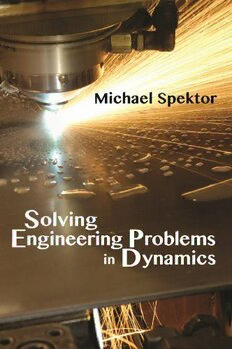Table Of ContentSSppeekkttoorr__FFMM..iinndddd ii 1144//0033//1144 33::4400 PPMM
SOLVING ENGINEERING
PROBLEMS IN DYNAMICS
By
MICHAEL B. SPEKTOR
Industrial Press
SSppeekkttoorr__FFMM..iinndddd ii 1144//0033//1144 33::4400 PPMM
A full catalog record for this book will be available from the Library of Congress
ISBN 978-0-8311-3494-5
Industrial Press, Inc.
32 Haviland Street
South Norwalk, Connecticut 06854
Sponsoring Editor: Jim Dodd
Interior Text and Cover Design: Janet Romano
Developmental Editor: Robert Weinstein
Copyright © 2014 by Industrial Press Inc., New York.
Printed in the United States of America.
All rights reserved.
This book, or any parts thereof, may not be reproduced,
stored in a retrieval system, or transmitted in any form
without the permission of the publisher.
1 2 3 4 5 6 7 8 9 10
SSppeekkttoorr__FFMM..iinndddd iiii 1144//0033//1144 33::4400 PPMM
To My Family
SSppeekkttoorr__FFMM..iinndddd iiiiii 1144//0033//1144 33::4400 PPMM
SSppeekkttoorr__FFMM..iinndddd iivv 1144//0033//1144 33::4400 PPMM
TABLE OF CONTENTS
Introduction ix
Chapter 1 Differential Equations of Motion 1
1.1 The Left Side of Differential Equations of Motion
(Sum of Resisting Loading Factors Equals Zero) 2
1.2 The Left and Right Sides of Differential Equations of Motion
(Sum of Resisting Loading Factors Equals Sum of Active
Loading Factors) 9
Chapter 2 Analysis of Forces 17
2.1 Analysis of Resisting Forces 17
2.1.1 Forces of Inertia 18
2.1.2 Damping Forces 19
2.1.3 Stiffness Forces 23
2.1.4 Constant Resisting Forces 28
2.1.5 Friction Forces 28
2.2 Analysis of Active Forces 29
2.2.1 Constant Active Forces 29
2.2.2 Sinusoidal Active Forces 29
2.2.3 Active Forces Depending on Time 29
2.2.4 Active Forces Depending on Velocity 30
2.2.5 Active Forces Depending on Displacement 30
SSppeekkttoorr__FFMM..iinndddd vv 1144//0033//1144 33::4400 PPMM
vi Table of Contents
Chapter 3 Solving Differential Equations of Motion
Using Laplace Transforms 33
3.1 Laplace Transform Pairs for Differential Equations of Motion 34
3.2 Decomposition of Proper Rational Fractions 40
3.3 Examples of Decomposition of Fractions 41
3.4 Examples of Solving Differential Equations of Motion 46
3.4.1 Motion by Inertia with no Resistance 46
3.4.2 Motion by Inertia with Resistance of Friction 48
3.4.3 Motion by Inertia with Damping Resistance 49
3.4.4 Free Vibrations 51
3.4.5 Motion Caused by Impact 55
3.4.6 Motion of a Damped System Subjected to a Time
Depending Force 59
3.4.7 Forced Motion with Damping and Stiffness 63
3.4.8 Forced Vibrations 65
Chapter 4 Analysis of Typical Mechanical
Engineering Systems 69
4.1 Lifting a Load 70
4.1.1 Acceleration 71
4.1.2 Braking 76
4.2 Water Vessel Dynamics 80
4.3 Dynamics of an Automobile 83
4.3.1 Acceleration 84
4.3.2 Braking 93
4.4. Acceleration of a Projectile in the Barrel 95
4.5 Reciprocation Cycle of a Spring-loaded Sliding Link 100
4.5.1 Forward Stroke Due to a Constant Force 101
SSppeekkttoorr__FFMM..iinndddd vvii 1144//0033//1144 33::4400 PPMM
Table of Contents vii
4.5.2 Forward Stroke Due to Initial Velocity 104
4.5.3 Backward Stroke 108
4.6 Pneumatically Operated Soil Penetrating Machine 110
Chapter 5 Piece-Wise Linear Approximation 115
5.1 Penetrating into an Elasto-Plastic Medium 117
5.1.1 First Interval 119
5.1.2 Second Interval 122
5.1.3 Third Interval 124
5.1.4 Fourth Interval 126
5.2 Non-linear Damping Resistance 129
5.2.1 First Interval 131
5.2.2 Second Interval 133
Chapter 6 Dynamics of Two-Degree-of-Freedom Systems 137
6.1 Differential Equations of Motion: A Two-Degree-of-
Freedom System 140
6.1.1 A System with a Hydraulic Link (Dashpot) 140
6.1.2 A System with an Elastic Link (Spring) 142
6.1.3 A System with a Combination of a Hydraulic Link
(Dashpot) and an Elastic Link (Spring) 144
6.2 Solutions of Differential Equations of Motion for
Two-Degree-of-Freedom Systems 145
6.2.1 Solutions for a System with a Hydraulic Link 145
6.2.2 Solutions for a System with an Elastic Link 148
6.2.3 Solutions for a System with a Combination
of a Hydraulic and an Elastic Link 152
SSppeekkttoorr__FFMM..iinndddd vviiii 1144//0033//1144 33::4400 PPMM
viii Table of Contents
6.2.4 A System with a Hydraulic Link where the First
Mass Is Subjected to a Constant External Force 158
6.2.5 A Vibratory System Subjected to an External
Sinusoidal Force 163
Index 169
SSppeekkttoorr__FFMM..iinndddd vviiiiii 1144//0033//1144 33::4400 PPMM
INTRODUCTION
Purposeful control and improvement of how existing mechanical
systems perform is an important real-life problem, as is the develop-
ment of new systems. We can obtain solutions to these problems by
investigating the working processes of machines and their units and
elements. These investigations should be based on fundamentals of
dynamics combined with a variety of related sciences. The working
processes that characterize system performance can be described by
mathematical expressions that actually represent equations of motion
of these systems. Analyzing these equations of motion reveals the
relationship between the parameters of the system and their infl u-
ence on performance and other system characteristics or elements.
This book contains comprehensive methods for analyzing the
motion of engineering systems and their components. The analysis
covers three basic phases: 1) composing the differential equation of
motion, 2) solving the differential equation of motion, and 3) analyz-
ing the solution. Engineering education provides the fundamental
skills for completing these three phases. However, many engineers
would benefi t from additional training in using these fundamen-
tals to solve real-life engineering problems. This book provides this
training by describing in a step-by-step order the methods related to
each of these three phases.
When assembling a differential equation of motion, it is essential
to completely understand the components of this equation as well
as the system’s working process. This book describes all possible
components of the differential equation of motion and all possible
factors of the working process. In mechanical engineering, all these
components and factors represent forces and moments. The charac-
teristics of all these loading factors and their application to particular
differential equations of motion are presented in this book.
This book also introduces a straightforward universal meth-
odology for solving differential equations of motion by using
the Laplace Transform. This approach replaces calculus with
SSppeekkttoorr__FFMM..iinndddd iixx 1144//0033//1144 33::4400 PPMM

